Fringe Benefits Tax Analysis: Shiny Homes Pty Ltd and Charlie Report
VerifiedAdded on 2019/10/30
|16
|3841
|254
Report
AI Summary
This report provides a comprehensive analysis of fringe benefits tax (FBT) in the context of Shiny Homes Pty Limited and its employee, Charlie. It begins with an introduction to taxation and the definition of fringe benefits, as outlined in the Fringe Benefits Tax Assessment Act 1986. The report addresses the key issue of whether Charlie received any fringe benefits during the tax period and the implications for both employer and employee. It delves into the specifics of FBT calculation, including taxable values for different fringe benefits like car fringe benefits and car parking fringe benefits. The report applies relevant sections of the FBT Act, such as sections 7 and 39A, to analyze Charlie's car and parking arrangements, including the use of a company car and parking at Secure Parking. It also highlights the merits and demerits of offering fringe benefits, such as employee motivation and potential administrative burdens. The report concludes with a detailed examination of the specific fringe benefits provided to Charlie, calculating the taxable values and discussing the tax implications for both parties involved. This report is a student submission, offering valuable insights into FBT principles and practical application.
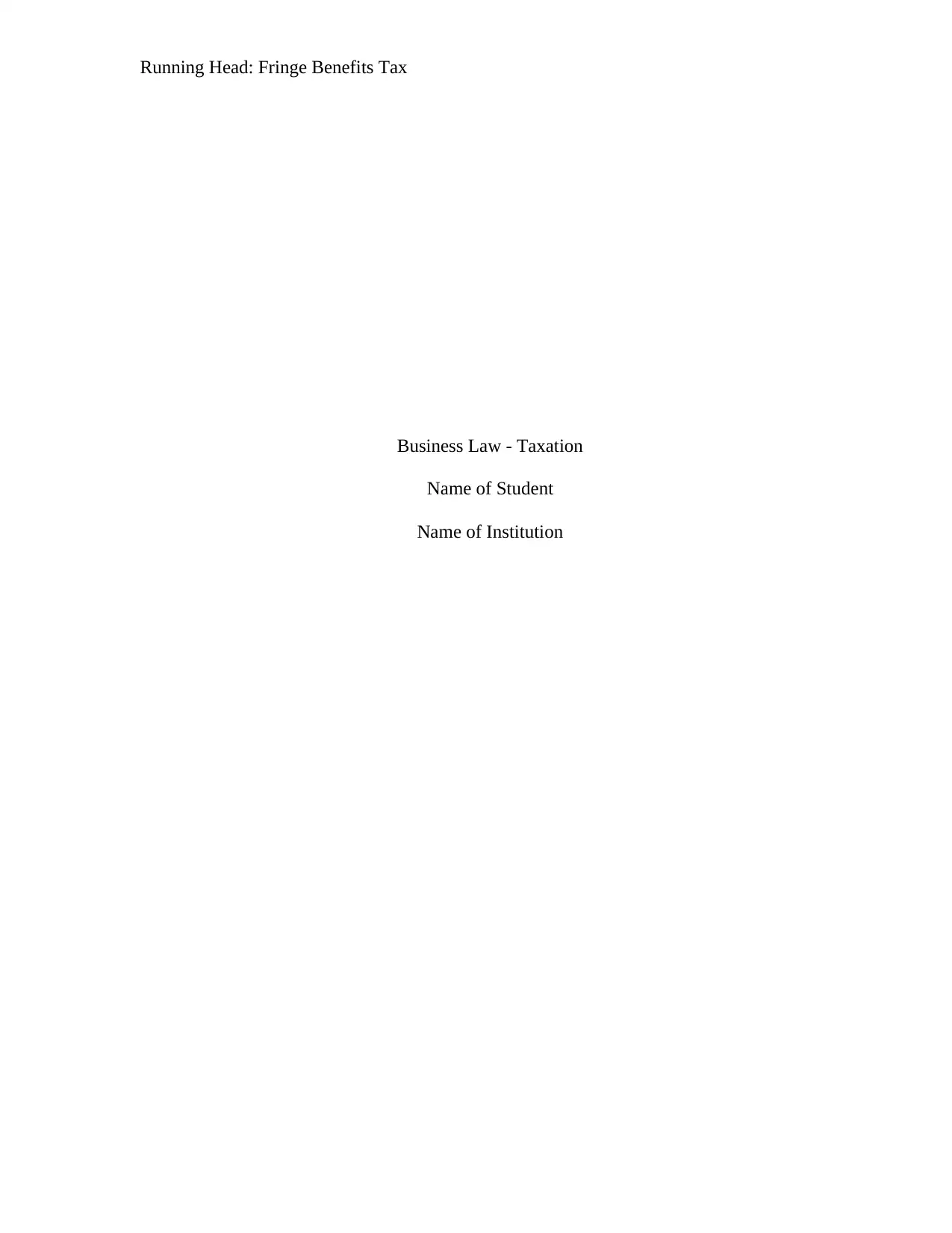
Running Head: Fringe Benefits Tax
Business Law - Taxation
Name of Student
Name of Institution
Business Law - Taxation
Name of Student
Name of Institution
Secure Best Marks with AI Grader
Need help grading? Try our AI Grader for instant feedback on your assignments.
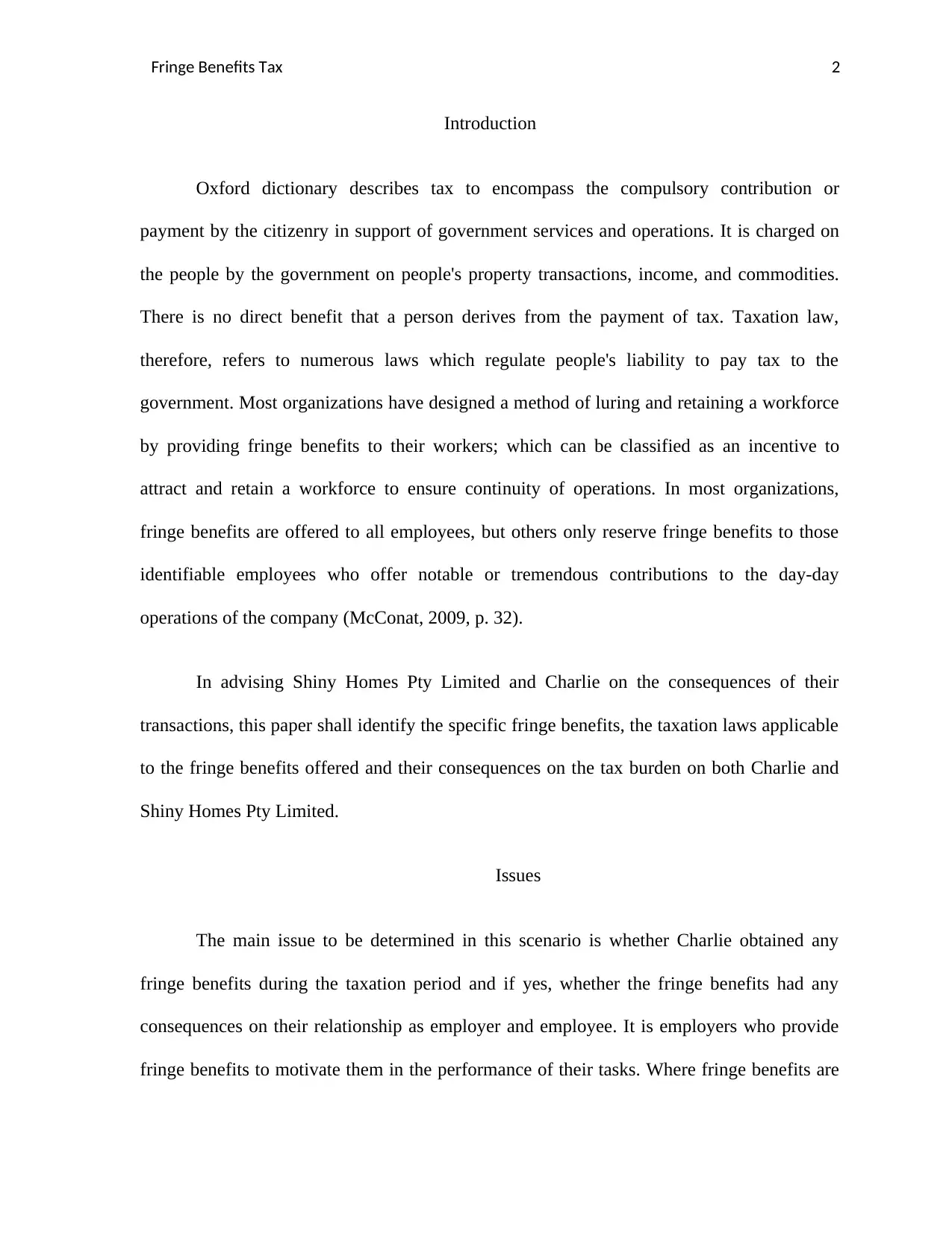
Fringe Benefits Tax 2
Introduction
Oxford dictionary describes tax to encompass the compulsory contribution or
payment by the citizenry in support of government services and operations. It is charged on
the people by the government on people's property transactions, income, and commodities.
There is no direct benefit that a person derives from the payment of tax. Taxation law,
therefore, refers to numerous laws which regulate people's liability to pay tax to the
government. Most organizations have designed a method of luring and retaining a workforce
by providing fringe benefits to their workers; which can be classified as an incentive to
attract and retain a workforce to ensure continuity of operations. In most organizations,
fringe benefits are offered to all employees, but others only reserve fringe benefits to those
identifiable employees who offer notable or tremendous contributions to the day-day
operations of the company (McConat, 2009, p. 32).
In advising Shiny Homes Pty Limited and Charlie on the consequences of their
transactions, this paper shall identify the specific fringe benefits, the taxation laws applicable
to the fringe benefits offered and their consequences on the tax burden on both Charlie and
Shiny Homes Pty Limited.
Issues
The main issue to be determined in this scenario is whether Charlie obtained any
fringe benefits during the taxation period and if yes, whether the fringe benefits had any
consequences on their relationship as employer and employee. It is employers who provide
fringe benefits to motivate them in the performance of their tasks. Where fringe benefits are
Introduction
Oxford dictionary describes tax to encompass the compulsory contribution or
payment by the citizenry in support of government services and operations. It is charged on
the people by the government on people's property transactions, income, and commodities.
There is no direct benefit that a person derives from the payment of tax. Taxation law,
therefore, refers to numerous laws which regulate people's liability to pay tax to the
government. Most organizations have designed a method of luring and retaining a workforce
by providing fringe benefits to their workers; which can be classified as an incentive to
attract and retain a workforce to ensure continuity of operations. In most organizations,
fringe benefits are offered to all employees, but others only reserve fringe benefits to those
identifiable employees who offer notable or tremendous contributions to the day-day
operations of the company (McConat, 2009, p. 32).
In advising Shiny Homes Pty Limited and Charlie on the consequences of their
transactions, this paper shall identify the specific fringe benefits, the taxation laws applicable
to the fringe benefits offered and their consequences on the tax burden on both Charlie and
Shiny Homes Pty Limited.
Issues
The main issue to be determined in this scenario is whether Charlie obtained any
fringe benefits during the taxation period and if yes, whether the fringe benefits had any
consequences on their relationship as employer and employee. It is employers who provide
fringe benefits to motivate them in the performance of their tasks. Where fringe benefits are
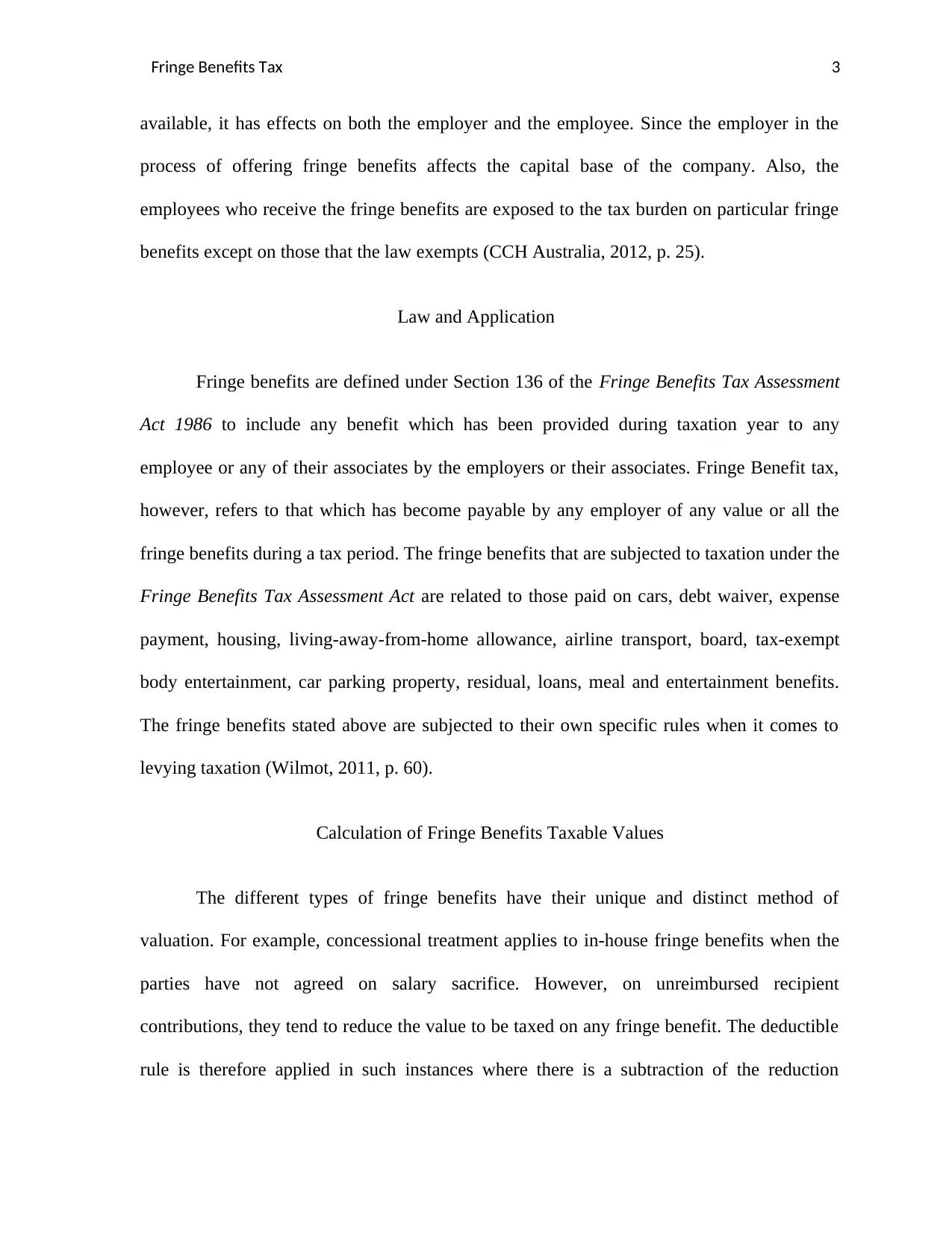
Fringe Benefits Tax 3
available, it has effects on both the employer and the employee. Since the employer in the
process of offering fringe benefits affects the capital base of the company. Also, the
employees who receive the fringe benefits are exposed to the tax burden on particular fringe
benefits except on those that the law exempts (CCH Australia, 2012, p. 25).
Law and Application
Fringe benefits are defined under Section 136 of the Fringe Benefits Tax Assessment
Act 1986 to include any benefit which has been provided during taxation year to any
employee or any of their associates by the employers or their associates. Fringe Benefit tax,
however, refers to that which has become payable by any employer of any value or all the
fringe benefits during a tax period. The fringe benefits that are subjected to taxation under the
Fringe Benefits Tax Assessment Act are related to those paid on cars, debt waiver, expense
payment, housing, living-away-from-home allowance, airline transport, board, tax-exempt
body entertainment, car parking property, residual, loans, meal and entertainment benefits.
The fringe benefits stated above are subjected to their own specific rules when it comes to
levying taxation (Wilmot, 2011, p. 60).
Calculation of Fringe Benefits Taxable Values
The different types of fringe benefits have their unique and distinct method of
valuation. For example, concessional treatment applies to in-house fringe benefits when the
parties have not agreed on salary sacrifice. However, on unreimbursed recipient
contributions, they tend to reduce the value to be taxed on any fringe benefit. The deductible
rule is therefore applied in such instances where there is a subtraction of the reduction
available, it has effects on both the employer and the employee. Since the employer in the
process of offering fringe benefits affects the capital base of the company. Also, the
employees who receive the fringe benefits are exposed to the tax burden on particular fringe
benefits except on those that the law exempts (CCH Australia, 2012, p. 25).
Law and Application
Fringe benefits are defined under Section 136 of the Fringe Benefits Tax Assessment
Act 1986 to include any benefit which has been provided during taxation year to any
employee or any of their associates by the employers or their associates. Fringe Benefit tax,
however, refers to that which has become payable by any employer of any value or all the
fringe benefits during a tax period. The fringe benefits that are subjected to taxation under the
Fringe Benefits Tax Assessment Act are related to those paid on cars, debt waiver, expense
payment, housing, living-away-from-home allowance, airline transport, board, tax-exempt
body entertainment, car parking property, residual, loans, meal and entertainment benefits.
The fringe benefits stated above are subjected to their own specific rules when it comes to
levying taxation (Wilmot, 2011, p. 60).
Calculation of Fringe Benefits Taxable Values
The different types of fringe benefits have their unique and distinct method of
valuation. For example, concessional treatment applies to in-house fringe benefits when the
parties have not agreed on salary sacrifice. However, on unreimbursed recipient
contributions, they tend to reduce the value to be taxed on any fringe benefit. The deductible
rule is therefore applied in such instances where there is a subtraction of the reduction
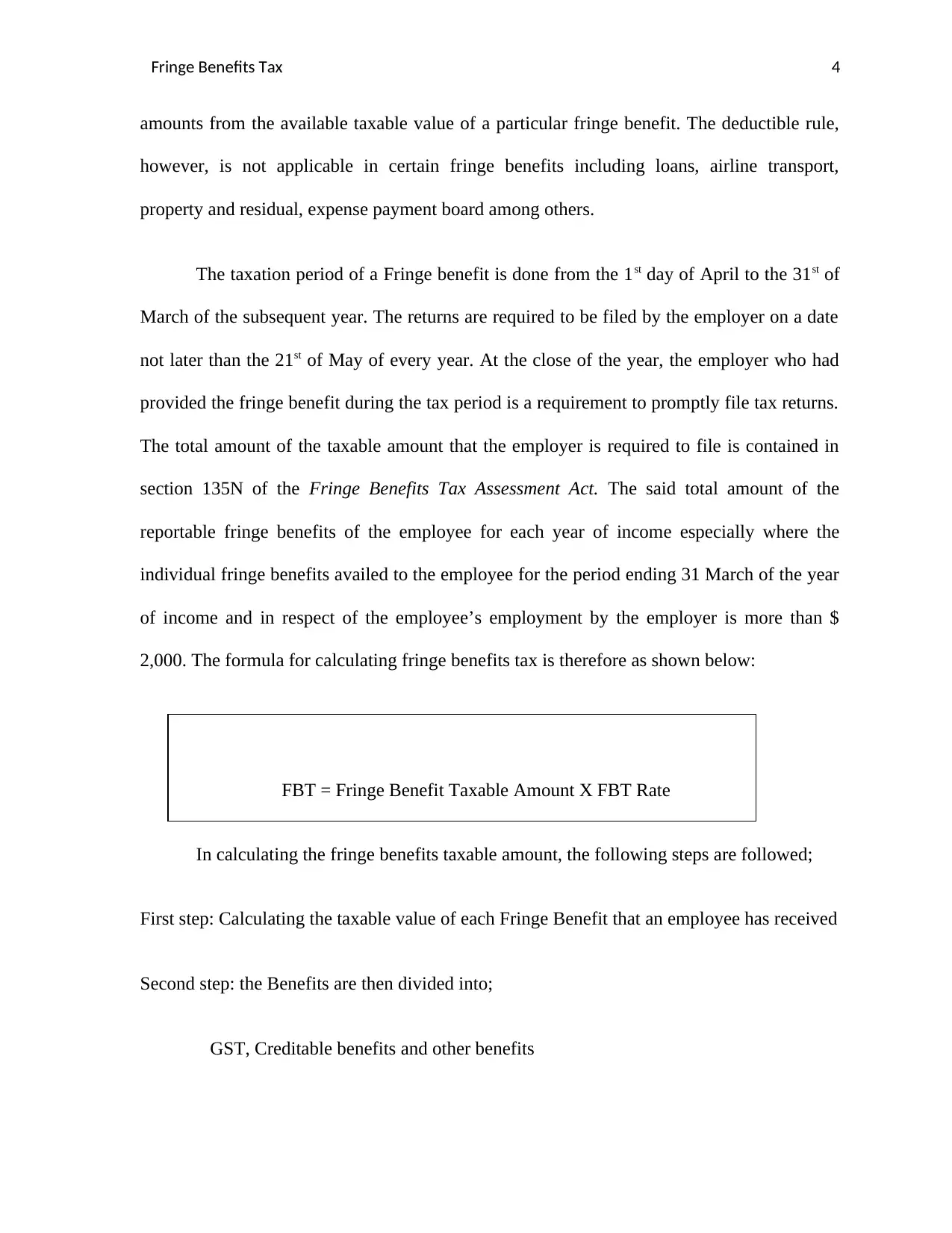
Fringe Benefits Tax 4
amounts from the available taxable value of a particular fringe benefit. The deductible rule,
however, is not applicable in certain fringe benefits including loans, airline transport,
property and residual, expense payment board among others.
The taxation period of a Fringe benefit is done from the 1st day of April to the 31st of
March of the subsequent year. The returns are required to be filed by the employer on a date
not later than the 21st of May of every year. At the close of the year, the employer who had
provided the fringe benefit during the tax period is a requirement to promptly file tax returns.
The total amount of the taxable amount that the employer is required to file is contained in
section 135N of the Fringe Benefits Tax Assessment Act. The said total amount of the
reportable fringe benefits of the employee for each year of income especially where the
individual fringe benefits availed to the employee for the period ending 31 March of the year
of income and in respect of the employee’s employment by the employer is more than $
2,000. The formula for calculating fringe benefits tax is therefore as shown below:
FBT = Fringe Benefit Taxable Amount X FBT Rate
In calculating the fringe benefits taxable amount, the following steps are followed;
First step: Calculating the taxable value of each Fringe Benefit that an employee has received
Second step: the Benefits are then divided into;
GST, Creditable benefits and other benefits
amounts from the available taxable value of a particular fringe benefit. The deductible rule,
however, is not applicable in certain fringe benefits including loans, airline transport,
property and residual, expense payment board among others.
The taxation period of a Fringe benefit is done from the 1st day of April to the 31st of
March of the subsequent year. The returns are required to be filed by the employer on a date
not later than the 21st of May of every year. At the close of the year, the employer who had
provided the fringe benefit during the tax period is a requirement to promptly file tax returns.
The total amount of the taxable amount that the employer is required to file is contained in
section 135N of the Fringe Benefits Tax Assessment Act. The said total amount of the
reportable fringe benefits of the employee for each year of income especially where the
individual fringe benefits availed to the employee for the period ending 31 March of the year
of income and in respect of the employee’s employment by the employer is more than $
2,000. The formula for calculating fringe benefits tax is therefore as shown below:
FBT = Fringe Benefit Taxable Amount X FBT Rate
In calculating the fringe benefits taxable amount, the following steps are followed;
First step: Calculating the taxable value of each Fringe Benefit that an employee has received
Second step: the Benefits are then divided into;
GST, Creditable benefits and other benefits
Secure Best Marks with AI Grader
Need help grading? Try our AI Grader for instant feedback on your assignments.
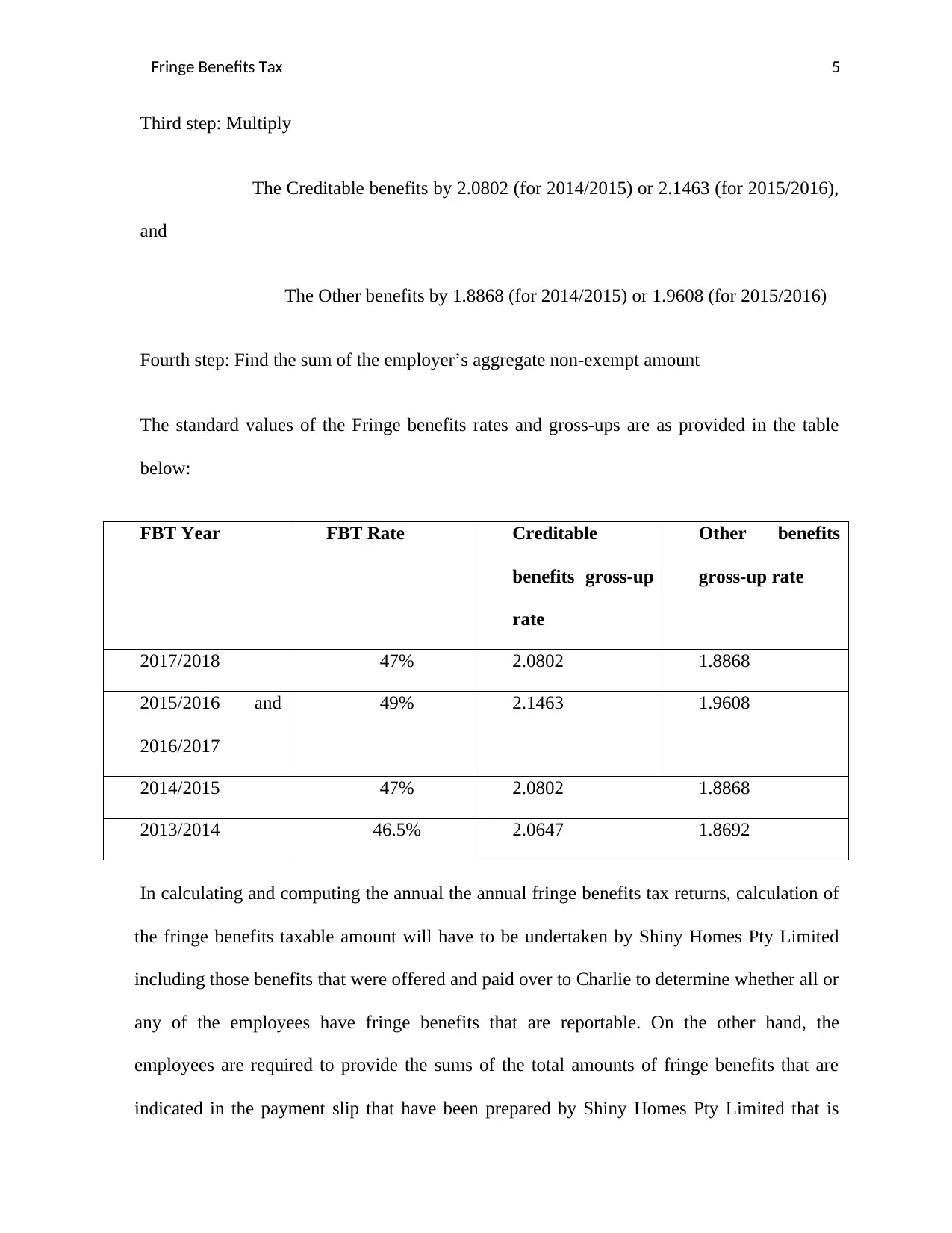
Fringe Benefits Tax 5
Third step: Multiply
The Creditable benefits by 2.0802 (for 2014/2015) or 2.1463 (for 2015/2016),
and
The Other benefits by 1.8868 (for 2014/2015) or 1.9608 (for 2015/2016)
Fourth step: Find the sum of the employer’s aggregate non-exempt amount
The standard values of the Fringe benefits rates and gross-ups are as provided in the table
below:
FBT Year FBT Rate Creditable
benefits gross-up
rate
Other benefits
gross-up rate
2017/2018 47% 2.0802 1.8868
2015/2016 and
2016/2017
49% 2.1463 1.9608
2014/2015 47% 2.0802 1.8868
2013/2014 46.5% 2.0647 1.8692
In calculating and computing the annual the annual fringe benefits tax returns, calculation of
the fringe benefits taxable amount will have to be undertaken by Shiny Homes Pty Limited
including those benefits that were offered and paid over to Charlie to determine whether all or
any of the employees have fringe benefits that are reportable. On the other hand, the
employees are required to provide the sums of the total amounts of fringe benefits that are
indicated in the payment slip that have been prepared by Shiny Homes Pty Limited that is
Third step: Multiply
The Creditable benefits by 2.0802 (for 2014/2015) or 2.1463 (for 2015/2016),
and
The Other benefits by 1.8868 (for 2014/2015) or 1.9608 (for 2015/2016)
Fourth step: Find the sum of the employer’s aggregate non-exempt amount
The standard values of the Fringe benefits rates and gross-ups are as provided in the table
below:
FBT Year FBT Rate Creditable
benefits gross-up
rate
Other benefits
gross-up rate
2017/2018 47% 2.0802 1.8868
2015/2016 and
2016/2017
49% 2.1463 1.9608
2014/2015 47% 2.0802 1.8868
2013/2014 46.5% 2.0647 1.8692
In calculating and computing the annual the annual fringe benefits tax returns, calculation of
the fringe benefits taxable amount will have to be undertaken by Shiny Homes Pty Limited
including those benefits that were offered and paid over to Charlie to determine whether all or
any of the employees have fringe benefits that are reportable. On the other hand, the
employees are required to provide the sums of the total amounts of fringe benefits that are
indicated in the payment slip that have been prepared by Shiny Homes Pty Limited that is
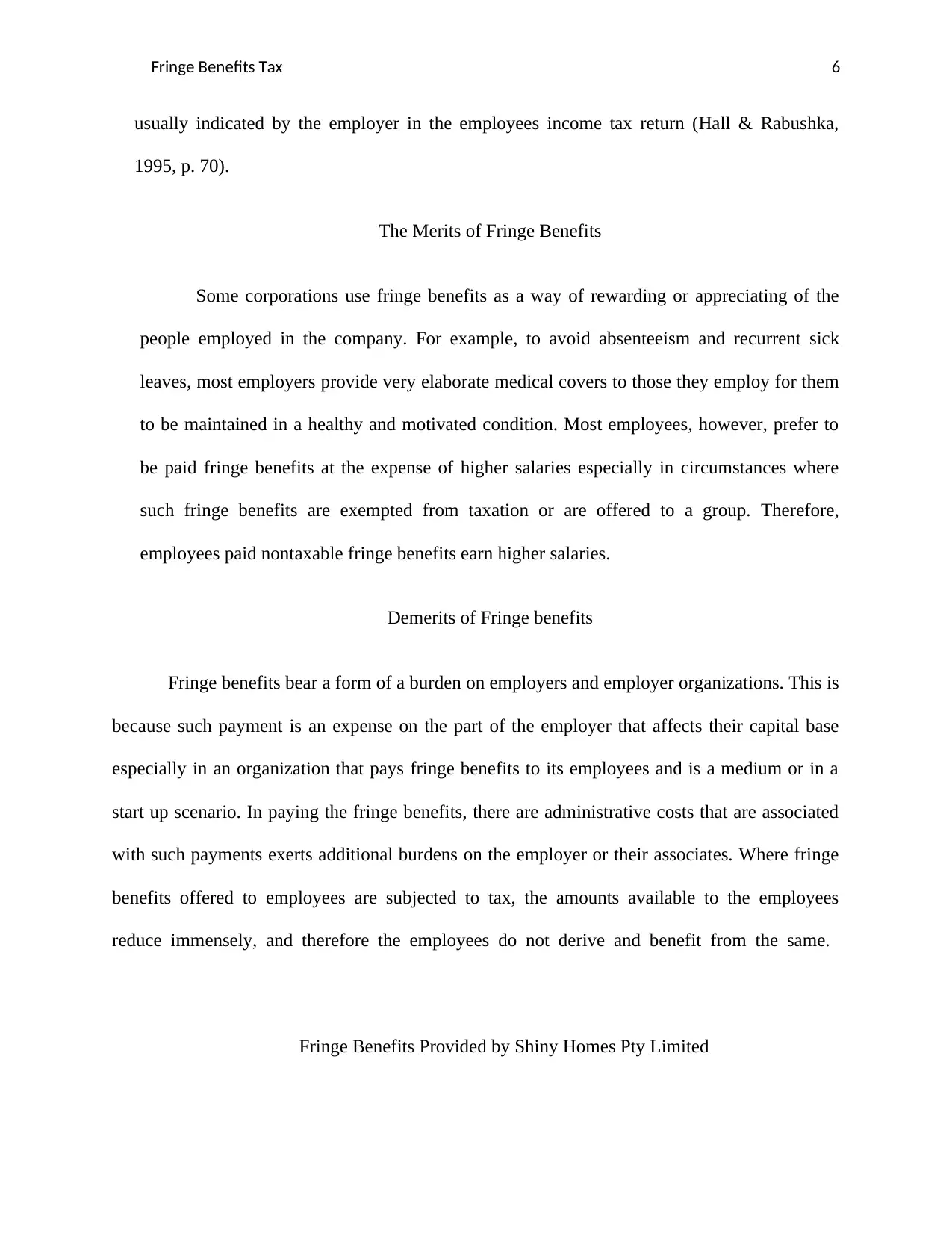
Fringe Benefits Tax 6
usually indicated by the employer in the employees income tax return (Hall & Rabushka,
1995, p. 70).
The Merits of Fringe Benefits
Some corporations use fringe benefits as a way of rewarding or appreciating of the
people employed in the company. For example, to avoid absenteeism and recurrent sick
leaves, most employers provide very elaborate medical covers to those they employ for them
to be maintained in a healthy and motivated condition. Most employees, however, prefer to
be paid fringe benefits at the expense of higher salaries especially in circumstances where
such fringe benefits are exempted from taxation or are offered to a group. Therefore,
employees paid nontaxable fringe benefits earn higher salaries.
Demerits of Fringe benefits
Fringe benefits bear a form of a burden on employers and employer organizations. This is
because such payment is an expense on the part of the employer that affects their capital base
especially in an organization that pays fringe benefits to its employees and is a medium or in a
start up scenario. In paying the fringe benefits, there are administrative costs that are associated
with such payments exerts additional burdens on the employer or their associates. Where fringe
benefits offered to employees are subjected to tax, the amounts available to the employees
reduce immensely, and therefore the employees do not derive and benefit from the same.
Fringe Benefits Provided by Shiny Homes Pty Limited
usually indicated by the employer in the employees income tax return (Hall & Rabushka,
1995, p. 70).
The Merits of Fringe Benefits
Some corporations use fringe benefits as a way of rewarding or appreciating of the
people employed in the company. For example, to avoid absenteeism and recurrent sick
leaves, most employers provide very elaborate medical covers to those they employ for them
to be maintained in a healthy and motivated condition. Most employees, however, prefer to
be paid fringe benefits at the expense of higher salaries especially in circumstances where
such fringe benefits are exempted from taxation or are offered to a group. Therefore,
employees paid nontaxable fringe benefits earn higher salaries.
Demerits of Fringe benefits
Fringe benefits bear a form of a burden on employers and employer organizations. This is
because such payment is an expense on the part of the employer that affects their capital base
especially in an organization that pays fringe benefits to its employees and is a medium or in a
start up scenario. In paying the fringe benefits, there are administrative costs that are associated
with such payments exerts additional burdens on the employer or their associates. Where fringe
benefits offered to employees are subjected to tax, the amounts available to the employees
reduce immensely, and therefore the employees do not derive and benefit from the same.
Fringe Benefits Provided by Shiny Homes Pty Limited
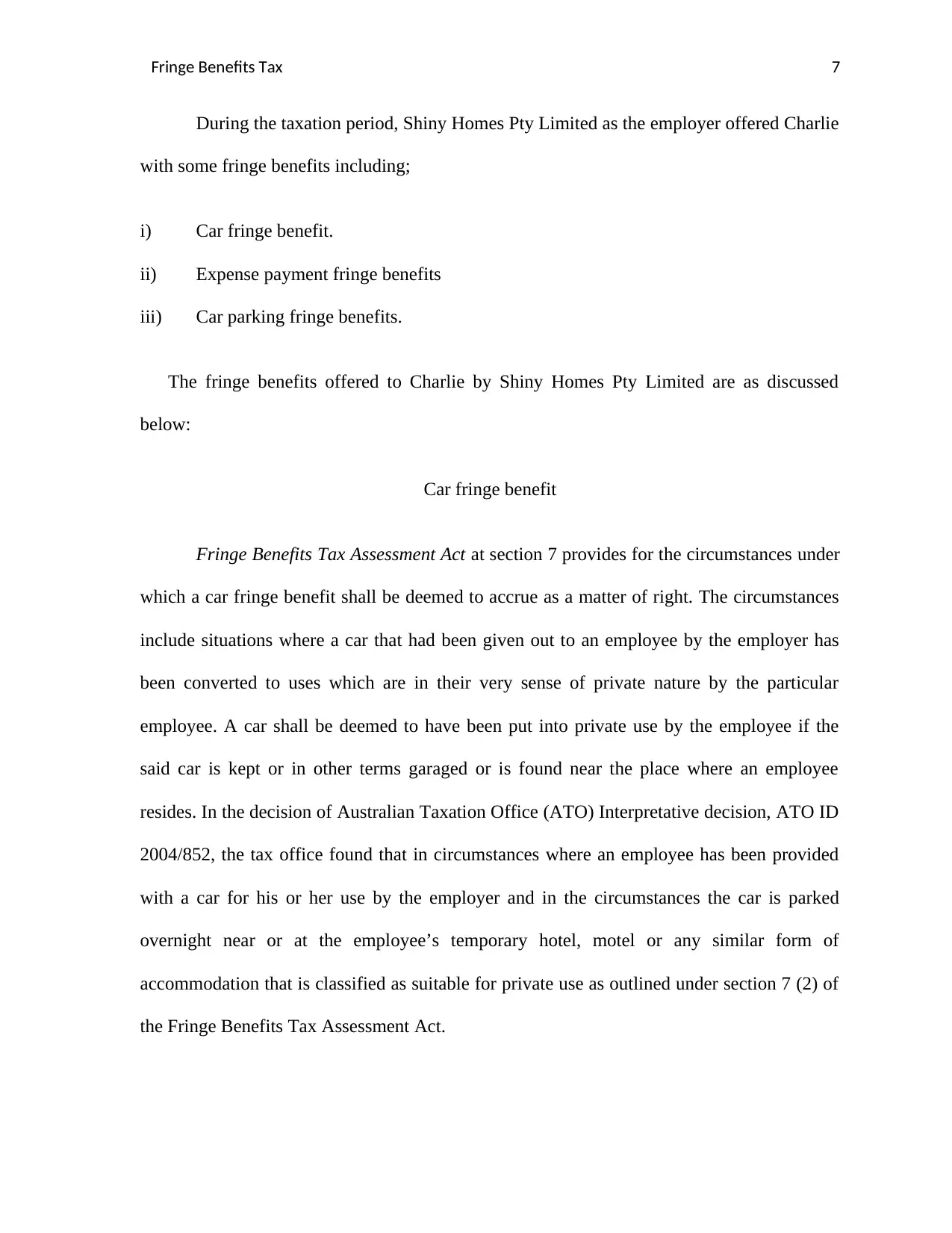
Fringe Benefits Tax 7
During the taxation period, Shiny Homes Pty Limited as the employer offered Charlie
with some fringe benefits including;
i) Car fringe benefit.
ii) Expense payment fringe benefits
iii) Car parking fringe benefits.
The fringe benefits offered to Charlie by Shiny Homes Pty Limited are as discussed
below:
Car fringe benefit
Fringe Benefits Tax Assessment Act at section 7 provides for the circumstances under
which a car fringe benefit shall be deemed to accrue as a matter of right. The circumstances
include situations where a car that had been given out to an employee by the employer has
been converted to uses which are in their very sense of private nature by the particular
employee. A car shall be deemed to have been put into private use by the employee if the
said car is kept or in other terms garaged or is found near the place where an employee
resides. In the decision of Australian Taxation Office (ATO) Interpretative decision, ATO ID
2004/852, the tax office found that in circumstances where an employee has been provided
with a car for his or her use by the employer and in the circumstances the car is parked
overnight near or at the employee’s temporary hotel, motel or any similar form of
accommodation that is classified as suitable for private use as outlined under section 7 (2) of
the Fringe Benefits Tax Assessment Act.
During the taxation period, Shiny Homes Pty Limited as the employer offered Charlie
with some fringe benefits including;
i) Car fringe benefit.
ii) Expense payment fringe benefits
iii) Car parking fringe benefits.
The fringe benefits offered to Charlie by Shiny Homes Pty Limited are as discussed
below:
Car fringe benefit
Fringe Benefits Tax Assessment Act at section 7 provides for the circumstances under
which a car fringe benefit shall be deemed to accrue as a matter of right. The circumstances
include situations where a car that had been given out to an employee by the employer has
been converted to uses which are in their very sense of private nature by the particular
employee. A car shall be deemed to have been put into private use by the employee if the
said car is kept or in other terms garaged or is found near the place where an employee
resides. In the decision of Australian Taxation Office (ATO) Interpretative decision, ATO ID
2004/852, the tax office found that in circumstances where an employee has been provided
with a car for his or her use by the employer and in the circumstances the car is parked
overnight near or at the employee’s temporary hotel, motel or any similar form of
accommodation that is classified as suitable for private use as outlined under section 7 (2) of
the Fringe Benefits Tax Assessment Act.
Paraphrase This Document
Need a fresh take? Get an instant paraphrase of this document with our AI Paraphraser
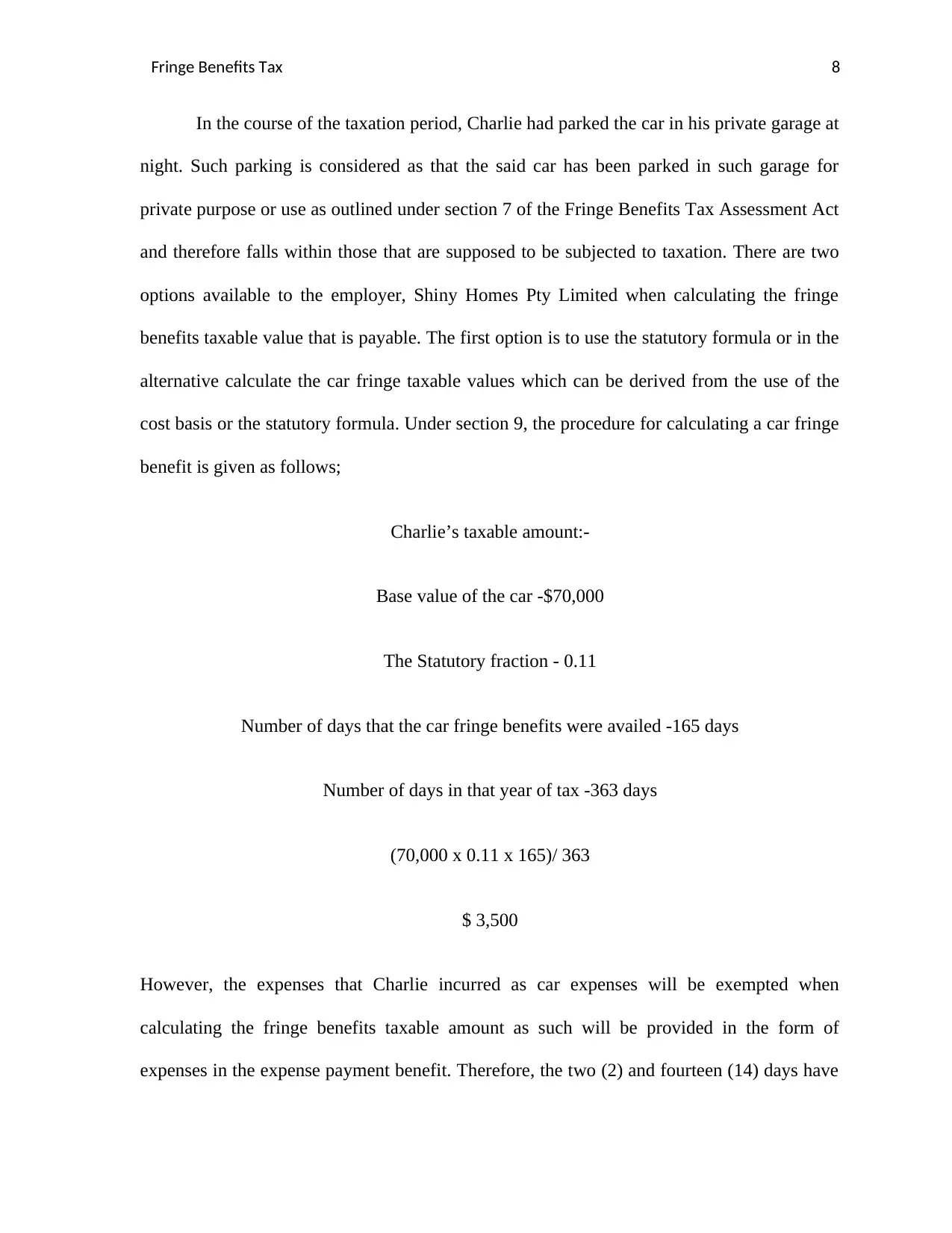
Fringe Benefits Tax 8
In the course of the taxation period, Charlie had parked the car in his private garage at
night. Such parking is considered as that the said car has been parked in such garage for
private purpose or use as outlined under section 7 of the Fringe Benefits Tax Assessment Act
and therefore falls within those that are supposed to be subjected to taxation. There are two
options available to the employer, Shiny Homes Pty Limited when calculating the fringe
benefits taxable value that is payable. The first option is to use the statutory formula or in the
alternative calculate the car fringe taxable values which can be derived from the use of the
cost basis or the statutory formula. Under section 9, the procedure for calculating a car fringe
benefit is given as follows;
Charlie’s taxable amount:-
Base value of the car -$70,000
The Statutory fraction - 0.11
Number of days that the car fringe benefits were availed -165 days
Number of days in that year of tax -363 days
(70,000 x 0.11 x 165)/ 363
$ 3,500
However, the expenses that Charlie incurred as car expenses will be exempted when
calculating the fringe benefits taxable amount as such will be provided in the form of
expenses in the expense payment benefit. Therefore, the two (2) and fourteen (14) days have
In the course of the taxation period, Charlie had parked the car in his private garage at
night. Such parking is considered as that the said car has been parked in such garage for
private purpose or use as outlined under section 7 of the Fringe Benefits Tax Assessment Act
and therefore falls within those that are supposed to be subjected to taxation. There are two
options available to the employer, Shiny Homes Pty Limited when calculating the fringe
benefits taxable value that is payable. The first option is to use the statutory formula or in the
alternative calculate the car fringe taxable values which can be derived from the use of the
cost basis or the statutory formula. Under section 9, the procedure for calculating a car fringe
benefit is given as follows;
Charlie’s taxable amount:-
Base value of the car -$70,000
The Statutory fraction - 0.11
Number of days that the car fringe benefits were availed -165 days
Number of days in that year of tax -363 days
(70,000 x 0.11 x 165)/ 363
$ 3,500
However, the expenses that Charlie incurred as car expenses will be exempted when
calculating the fringe benefits taxable amount as such will be provided in the form of
expenses in the expense payment benefit. Therefore, the two (2) and fourteen (14) days have
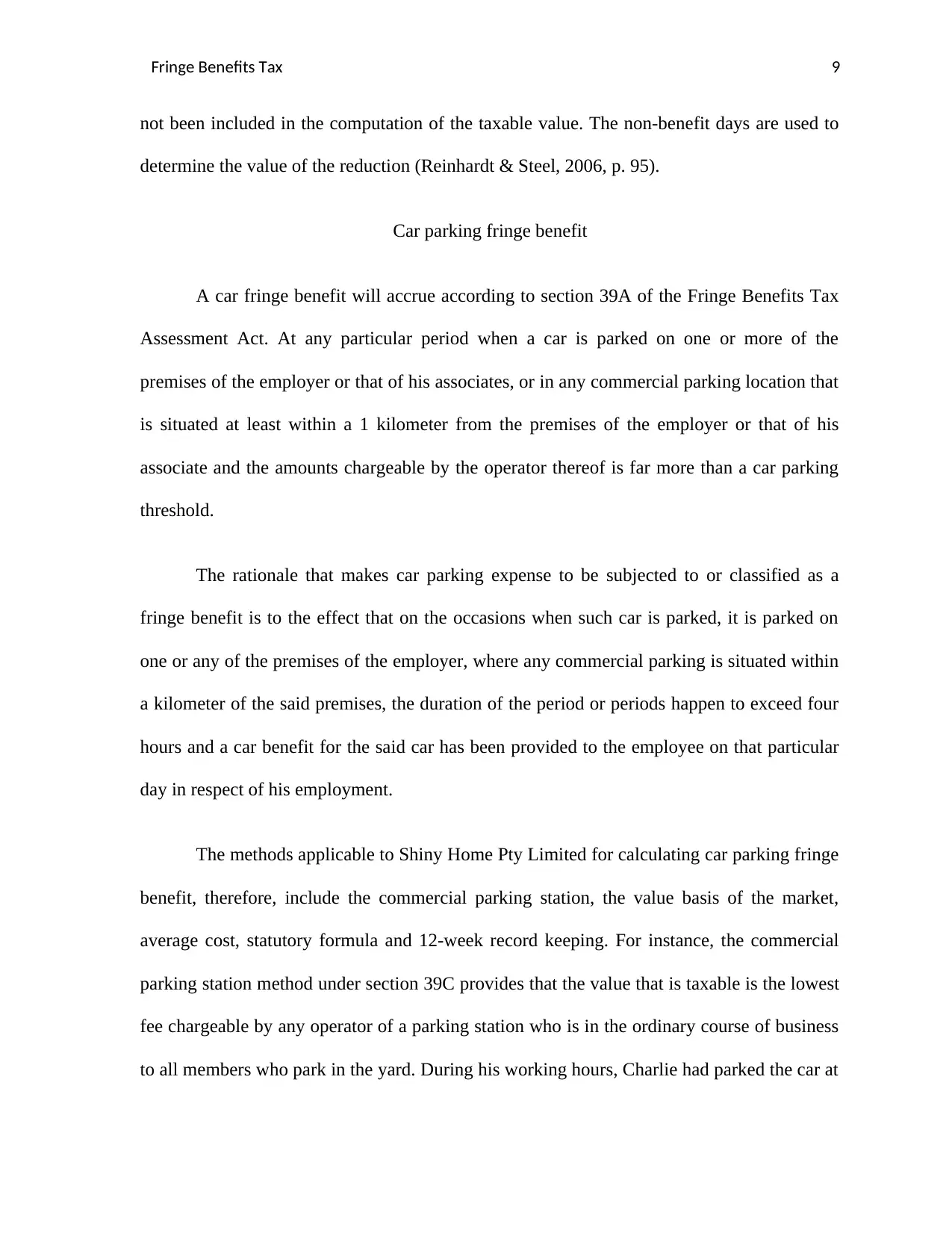
Fringe Benefits Tax 9
not been included in the computation of the taxable value. The non-benefit days are used to
determine the value of the reduction (Reinhardt & Steel, 2006, p. 95).
Car parking fringe benefit
A car fringe benefit will accrue according to section 39A of the Fringe Benefits Tax
Assessment Act. At any particular period when a car is parked on one or more of the
premises of the employer or that of his associates, or in any commercial parking location that
is situated at least within a 1 kilometer from the premises of the employer or that of his
associate and the amounts chargeable by the operator thereof is far more than a car parking
threshold.
The rationale that makes car parking expense to be subjected to or classified as a
fringe benefit is to the effect that on the occasions when such car is parked, it is parked on
one or any of the premises of the employer, where any commercial parking is situated within
a kilometer of the said premises, the duration of the period or periods happen to exceed four
hours and a car benefit for the said car has been provided to the employee on that particular
day in respect of his employment.
The methods applicable to Shiny Home Pty Limited for calculating car parking fringe
benefit, therefore, include the commercial parking station, the value basis of the market,
average cost, statutory formula and 12-week record keeping. For instance, the commercial
parking station method under section 39C provides that the value that is taxable is the lowest
fee chargeable by any operator of a parking station who is in the ordinary course of business
to all members who park in the yard. During his working hours, Charlie had parked the car at
not been included in the computation of the taxable value. The non-benefit days are used to
determine the value of the reduction (Reinhardt & Steel, 2006, p. 95).
Car parking fringe benefit
A car fringe benefit will accrue according to section 39A of the Fringe Benefits Tax
Assessment Act. At any particular period when a car is parked on one or more of the
premises of the employer or that of his associates, or in any commercial parking location that
is situated at least within a 1 kilometer from the premises of the employer or that of his
associate and the amounts chargeable by the operator thereof is far more than a car parking
threshold.
The rationale that makes car parking expense to be subjected to or classified as a
fringe benefit is to the effect that on the occasions when such car is parked, it is parked on
one or any of the premises of the employer, where any commercial parking is situated within
a kilometer of the said premises, the duration of the period or periods happen to exceed four
hours and a car benefit for the said car has been provided to the employee on that particular
day in respect of his employment.
The methods applicable to Shiny Home Pty Limited for calculating car parking fringe
benefit, therefore, include the commercial parking station, the value basis of the market,
average cost, statutory formula and 12-week record keeping. For instance, the commercial
parking station method under section 39C provides that the value that is taxable is the lowest
fee chargeable by any operator of a parking station who is in the ordinary course of business
to all members who park in the yard. During his working hours, Charlie had parked the car at
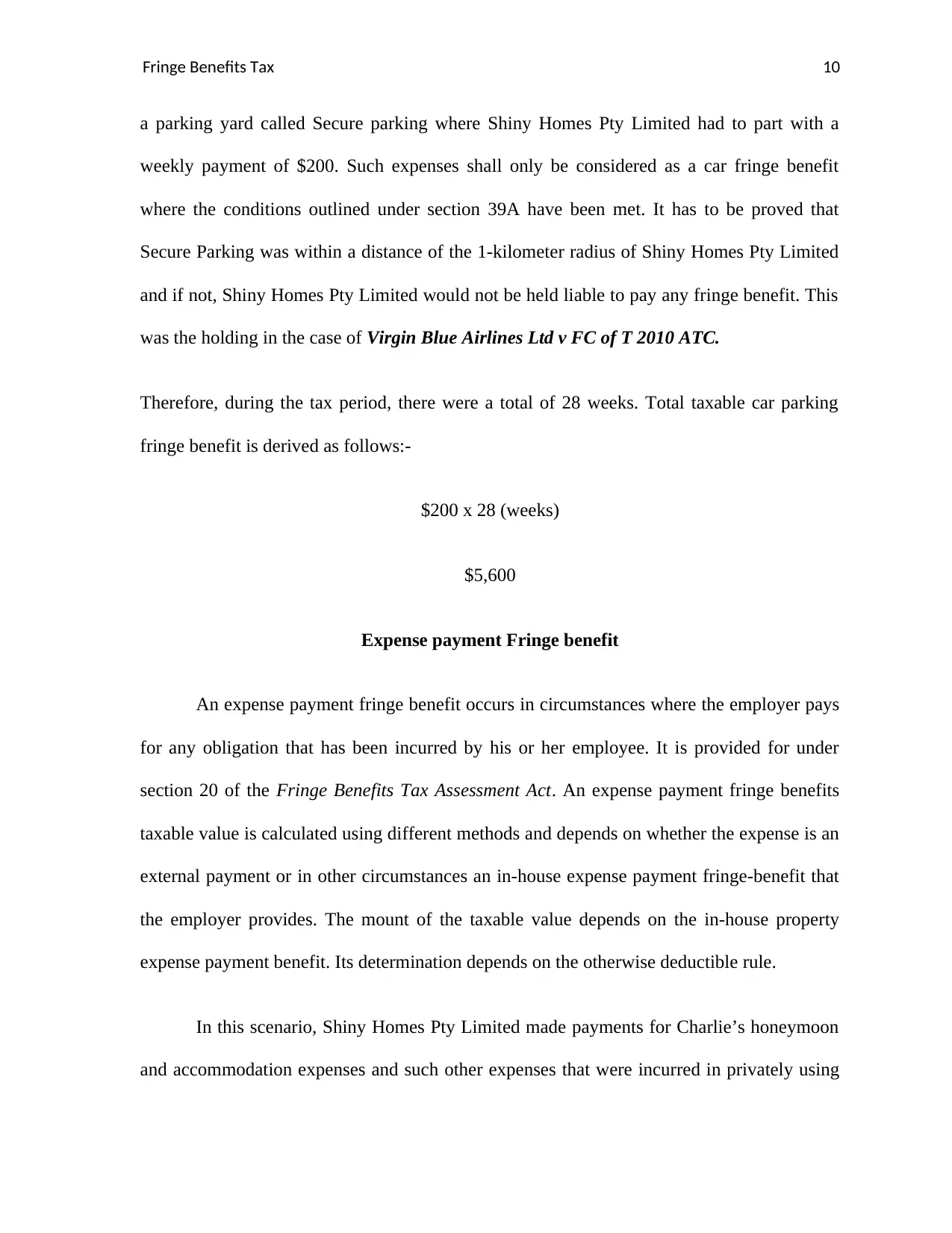
Fringe Benefits Tax 10
a parking yard called Secure parking where Shiny Homes Pty Limited had to part with a
weekly payment of $200. Such expenses shall only be considered as a car fringe benefit
where the conditions outlined under section 39A have been met. It has to be proved that
Secure Parking was within a distance of the 1-kilometer radius of Shiny Homes Pty Limited
and if not, Shiny Homes Pty Limited would not be held liable to pay any fringe benefit. This
was the holding in the case of Virgin Blue Airlines Ltd v FC of T 2010 ATC.
Therefore, during the tax period, there were a total of 28 weeks. Total taxable car parking
fringe benefit is derived as follows:-
$200 x 28 (weeks)
$5,600
Expense payment Fringe benefit
An expense payment fringe benefit occurs in circumstances where the employer pays
for any obligation that has been incurred by his or her employee. It is provided for under
section 20 of the Fringe Benefits Tax Assessment Act. An expense payment fringe benefits
taxable value is calculated using different methods and depends on whether the expense is an
external payment or in other circumstances an in-house expense payment fringe-benefit that
the employer provides. The mount of the taxable value depends on the in-house property
expense payment benefit. Its determination depends on the otherwise deductible rule.
In this scenario, Shiny Homes Pty Limited made payments for Charlie’s honeymoon
and accommodation expenses and such other expenses that were incurred in privately using
a parking yard called Secure parking where Shiny Homes Pty Limited had to part with a
weekly payment of $200. Such expenses shall only be considered as a car fringe benefit
where the conditions outlined under section 39A have been met. It has to be proved that
Secure Parking was within a distance of the 1-kilometer radius of Shiny Homes Pty Limited
and if not, Shiny Homes Pty Limited would not be held liable to pay any fringe benefit. This
was the holding in the case of Virgin Blue Airlines Ltd v FC of T 2010 ATC.
Therefore, during the tax period, there were a total of 28 weeks. Total taxable car parking
fringe benefit is derived as follows:-
$200 x 28 (weeks)
$5,600
Expense payment Fringe benefit
An expense payment fringe benefit occurs in circumstances where the employer pays
for any obligation that has been incurred by his or her employee. It is provided for under
section 20 of the Fringe Benefits Tax Assessment Act. An expense payment fringe benefits
taxable value is calculated using different methods and depends on whether the expense is an
external payment or in other circumstances an in-house expense payment fringe-benefit that
the employer provides. The mount of the taxable value depends on the in-house property
expense payment benefit. Its determination depends on the otherwise deductible rule.
In this scenario, Shiny Homes Pty Limited made payments for Charlie’s honeymoon
and accommodation expenses and such other expenses that were incurred in privately using
Secure Best Marks with AI Grader
Need help grading? Try our AI Grader for instant feedback on your assignments.
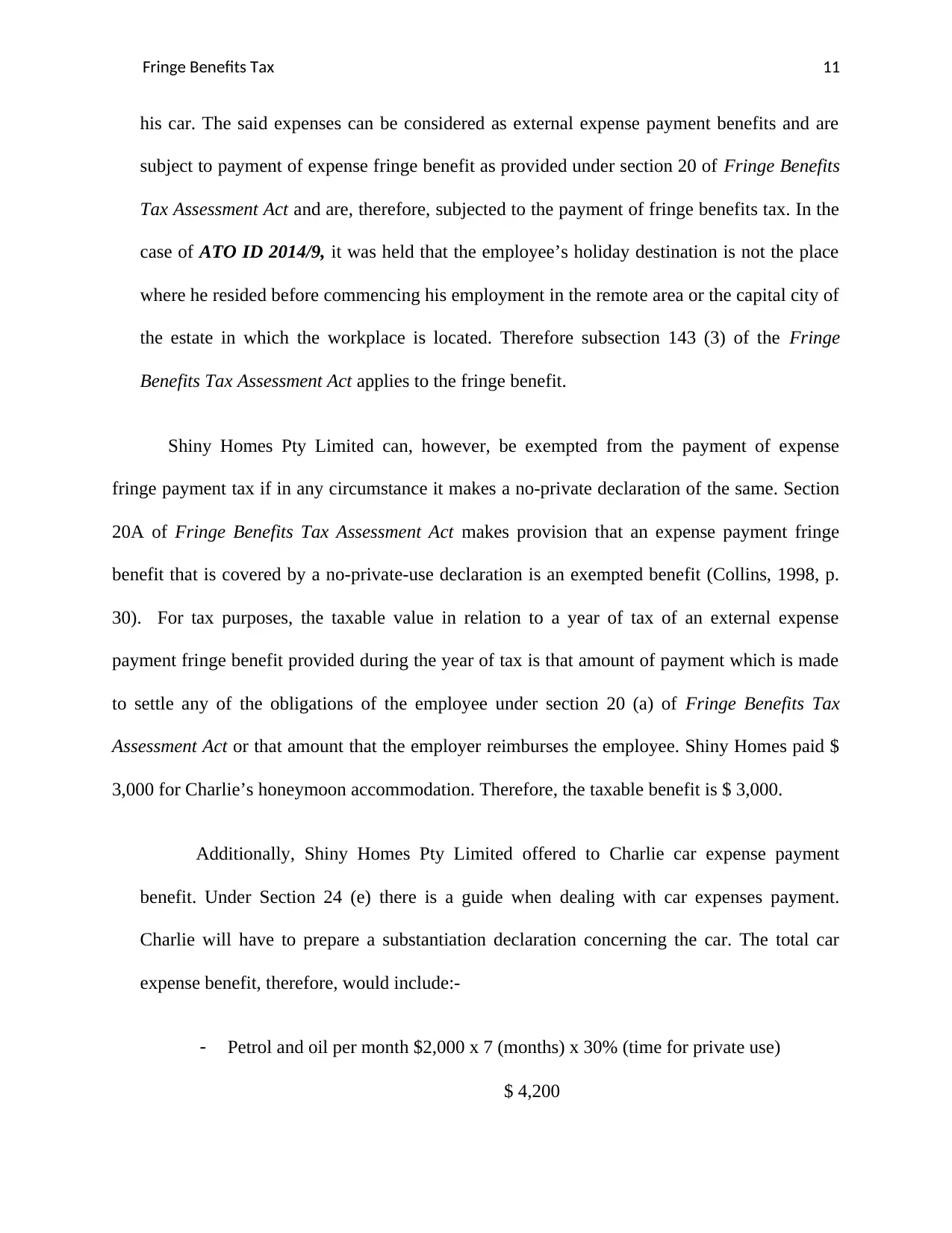
Fringe Benefits Tax 11
his car. The said expenses can be considered as external expense payment benefits and are
subject to payment of expense fringe benefit as provided under section 20 of Fringe Benefits
Tax Assessment Act and are, therefore, subjected to the payment of fringe benefits tax. In the
case of ATO ID 2014/9, it was held that the employee’s holiday destination is not the place
where he resided before commencing his employment in the remote area or the capital city of
the estate in which the workplace is located. Therefore subsection 143 (3) of the Fringe
Benefits Tax Assessment Act applies to the fringe benefit.
Shiny Homes Pty Limited can, however, be exempted from the payment of expense
fringe payment tax if in any circumstance it makes a no-private declaration of the same. Section
20A of Fringe Benefits Tax Assessment Act makes provision that an expense payment fringe
benefit that is covered by a no-private-use declaration is an exempted benefit (Collins, 1998, p.
30). For tax purposes, the taxable value in relation to a year of tax of an external expense
payment fringe benefit provided during the year of tax is that amount of payment which is made
to settle any of the obligations of the employee under section 20 (a) of Fringe Benefits Tax
Assessment Act or that amount that the employer reimburses the employee. Shiny Homes paid $
3,000 for Charlie’s honeymoon accommodation. Therefore, the taxable benefit is $ 3,000.
Additionally, Shiny Homes Pty Limited offered to Charlie car expense payment
benefit. Under Section 24 (e) there is a guide when dealing with car expenses payment.
Charlie will have to prepare a substantiation declaration concerning the car. The total car
expense benefit, therefore, would include:-
- Petrol and oil per month $2,000 x 7 (months) x 30% (time for private use)
$ 4,200
his car. The said expenses can be considered as external expense payment benefits and are
subject to payment of expense fringe benefit as provided under section 20 of Fringe Benefits
Tax Assessment Act and are, therefore, subjected to the payment of fringe benefits tax. In the
case of ATO ID 2014/9, it was held that the employee’s holiday destination is not the place
where he resided before commencing his employment in the remote area or the capital city of
the estate in which the workplace is located. Therefore subsection 143 (3) of the Fringe
Benefits Tax Assessment Act applies to the fringe benefit.
Shiny Homes Pty Limited can, however, be exempted from the payment of expense
fringe payment tax if in any circumstance it makes a no-private declaration of the same. Section
20A of Fringe Benefits Tax Assessment Act makes provision that an expense payment fringe
benefit that is covered by a no-private-use declaration is an exempted benefit (Collins, 1998, p.
30). For tax purposes, the taxable value in relation to a year of tax of an external expense
payment fringe benefit provided during the year of tax is that amount of payment which is made
to settle any of the obligations of the employee under section 20 (a) of Fringe Benefits Tax
Assessment Act or that amount that the employer reimburses the employee. Shiny Homes paid $
3,000 for Charlie’s honeymoon accommodation. Therefore, the taxable benefit is $ 3,000.
Additionally, Shiny Homes Pty Limited offered to Charlie car expense payment
benefit. Under Section 24 (e) there is a guide when dealing with car expenses payment.
Charlie will have to prepare a substantiation declaration concerning the car. The total car
expense benefit, therefore, would include:-
- Petrol and oil per month $2,000 x 7 (months) x 30% (time for private use)
$ 4,200
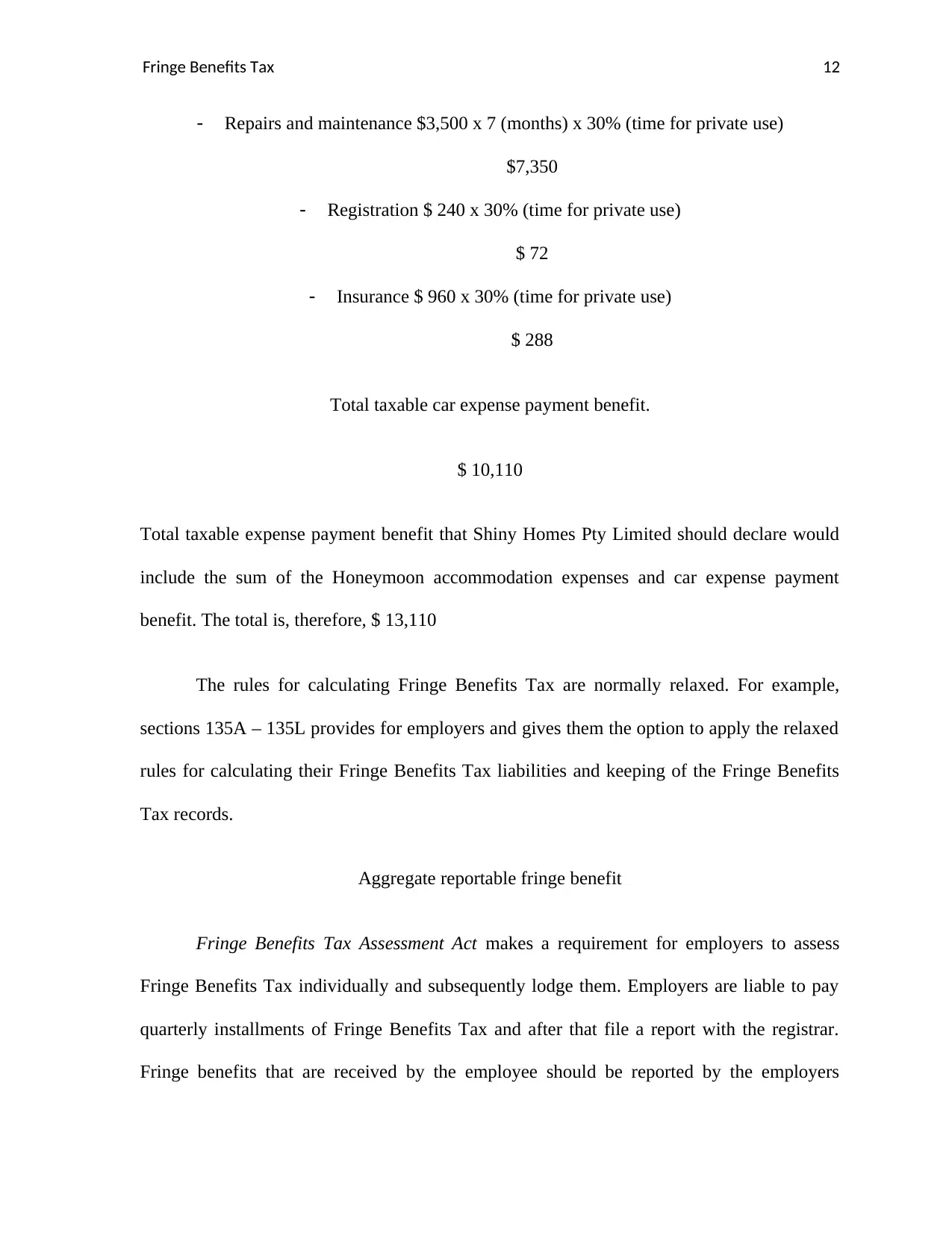
Fringe Benefits Tax 12
- Repairs and maintenance $3,500 x 7 (months) x 30% (time for private use)
$7,350
- Registration $ 240 x 30% (time for private use)
$ 72
- Insurance $ 960 x 30% (time for private use)
$ 288
Total taxable car expense payment benefit.
$ 10,110
Total taxable expense payment benefit that Shiny Homes Pty Limited should declare would
include the sum of the Honeymoon accommodation expenses and car expense payment
benefit. The total is, therefore, $ 13,110
The rules for calculating Fringe Benefits Tax are normally relaxed. For example,
sections 135A – 135L provides for employers and gives them the option to apply the relaxed
rules for calculating their Fringe Benefits Tax liabilities and keeping of the Fringe Benefits
Tax records.
Aggregate reportable fringe benefit
Fringe Benefits Tax Assessment Act makes a requirement for employers to assess
Fringe Benefits Tax individually and subsequently lodge them. Employers are liable to pay
quarterly installments of Fringe Benefits Tax and after that file a report with the registrar.
Fringe benefits that are received by the employee should be reported by the employers
- Repairs and maintenance $3,500 x 7 (months) x 30% (time for private use)
$7,350
- Registration $ 240 x 30% (time for private use)
$ 72
- Insurance $ 960 x 30% (time for private use)
$ 288
Total taxable car expense payment benefit.
$ 10,110
Total taxable expense payment benefit that Shiny Homes Pty Limited should declare would
include the sum of the Honeymoon accommodation expenses and car expense payment
benefit. The total is, therefore, $ 13,110
The rules for calculating Fringe Benefits Tax are normally relaxed. For example,
sections 135A – 135L provides for employers and gives them the option to apply the relaxed
rules for calculating their Fringe Benefits Tax liabilities and keeping of the Fringe Benefits
Tax records.
Aggregate reportable fringe benefit
Fringe Benefits Tax Assessment Act makes a requirement for employers to assess
Fringe Benefits Tax individually and subsequently lodge them. Employers are liable to pay
quarterly installments of Fringe Benefits Tax and after that file a report with the registrar.
Fringe benefits that are received by the employee should be reported by the employers
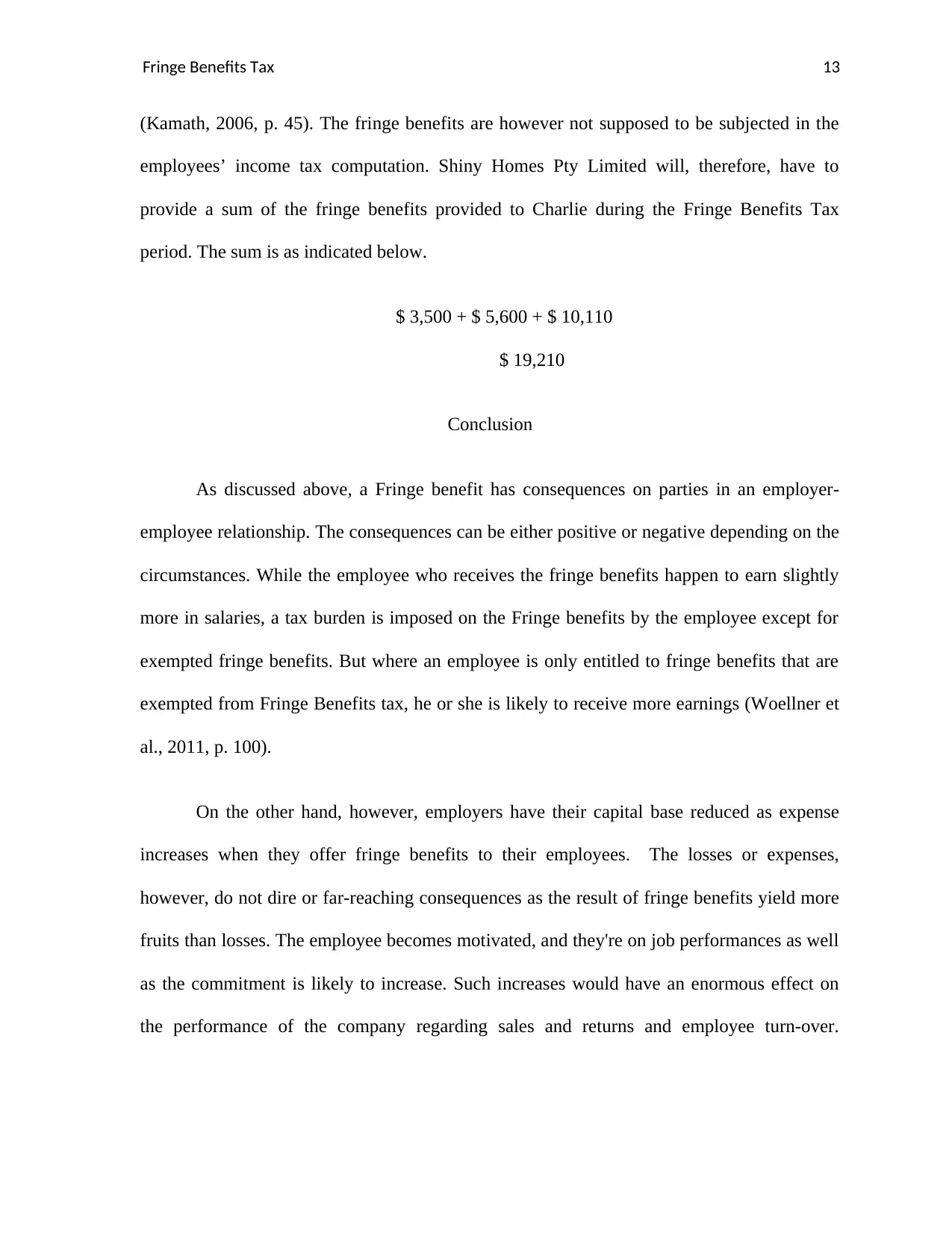
Fringe Benefits Tax 13
(Kamath, 2006, p. 45). The fringe benefits are however not supposed to be subjected in the
employees’ income tax computation. Shiny Homes Pty Limited will, therefore, have to
provide a sum of the fringe benefits provided to Charlie during the Fringe Benefits Tax
period. The sum is as indicated below.
$ 3,500 + $ 5,600 + $ 10,110
$ 19,210
Conclusion
As discussed above, a Fringe benefit has consequences on parties in an employer-
employee relationship. The consequences can be either positive or negative depending on the
circumstances. While the employee who receives the fringe benefits happen to earn slightly
more in salaries, a tax burden is imposed on the Fringe benefits by the employee except for
exempted fringe benefits. But where an employee is only entitled to fringe benefits that are
exempted from Fringe Benefits tax, he or she is likely to receive more earnings (Woellner et
al., 2011, p. 100).
On the other hand, however, employers have their capital base reduced as expense
increases when they offer fringe benefits to their employees. The losses or expenses,
however, do not dire or far-reaching consequences as the result of fringe benefits yield more
fruits than losses. The employee becomes motivated, and they're on job performances as well
as the commitment is likely to increase. Such increases would have an enormous effect on
the performance of the company regarding sales and returns and employee turn-over.
(Kamath, 2006, p. 45). The fringe benefits are however not supposed to be subjected in the
employees’ income tax computation. Shiny Homes Pty Limited will, therefore, have to
provide a sum of the fringe benefits provided to Charlie during the Fringe Benefits Tax
period. The sum is as indicated below.
$ 3,500 + $ 5,600 + $ 10,110
$ 19,210
Conclusion
As discussed above, a Fringe benefit has consequences on parties in an employer-
employee relationship. The consequences can be either positive or negative depending on the
circumstances. While the employee who receives the fringe benefits happen to earn slightly
more in salaries, a tax burden is imposed on the Fringe benefits by the employee except for
exempted fringe benefits. But where an employee is only entitled to fringe benefits that are
exempted from Fringe Benefits tax, he or she is likely to receive more earnings (Woellner et
al., 2011, p. 100).
On the other hand, however, employers have their capital base reduced as expense
increases when they offer fringe benefits to their employees. The losses or expenses,
however, do not dire or far-reaching consequences as the result of fringe benefits yield more
fruits than losses. The employee becomes motivated, and they're on job performances as well
as the commitment is likely to increase. Such increases would have an enormous effect on
the performance of the company regarding sales and returns and employee turn-over.
Paraphrase This Document
Need a fresh take? Get an instant paraphrase of this document with our AI Paraphraser
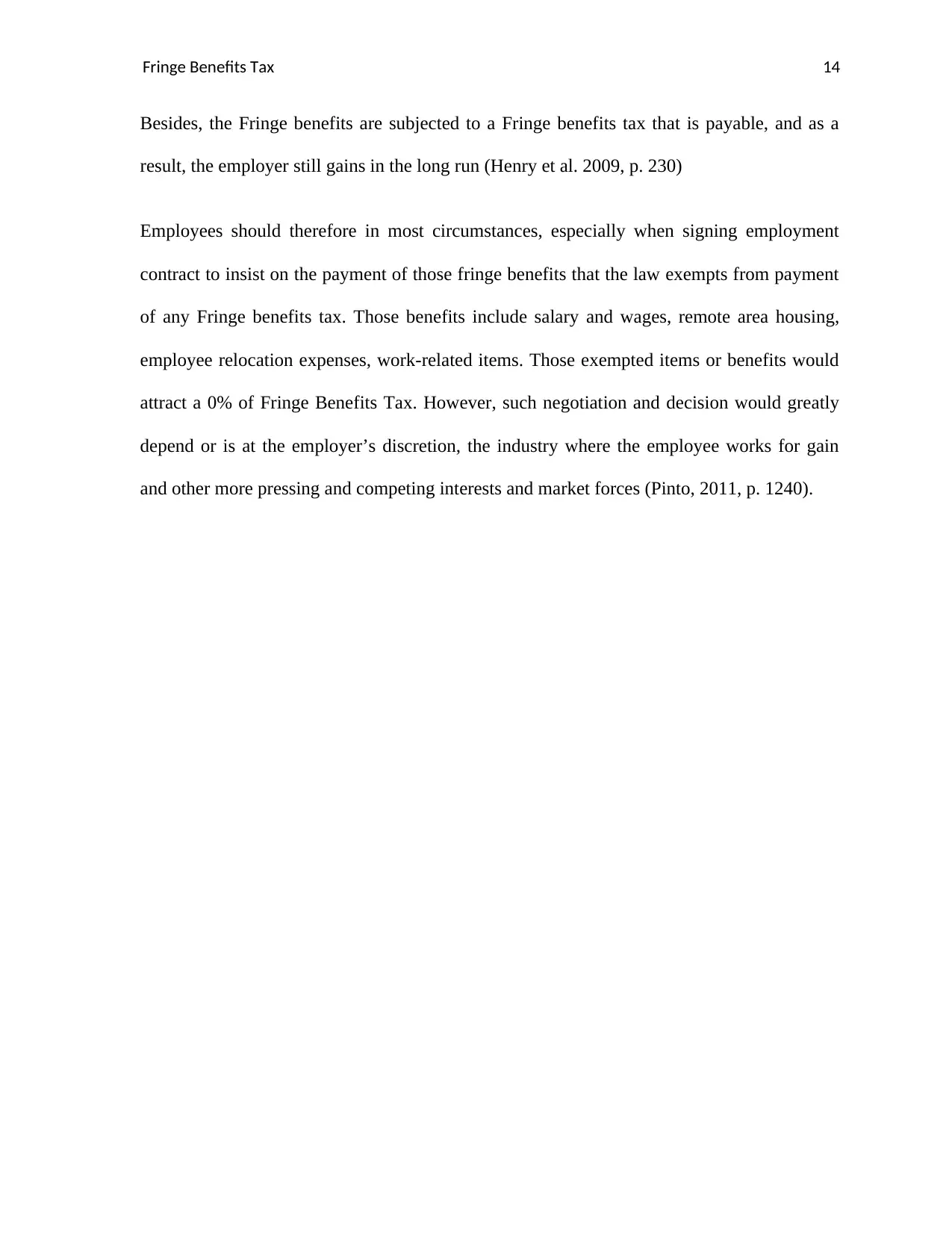
Fringe Benefits Tax 14
Besides, the Fringe benefits are subjected to a Fringe benefits tax that is payable, and as a
result, the employer still gains in the long run (Henry et al. 2009, p. 230)
Employees should therefore in most circumstances, especially when signing employment
contract to insist on the payment of those fringe benefits that the law exempts from payment
of any Fringe benefits tax. Those benefits include salary and wages, remote area housing,
employee relocation expenses, work-related items. Those exempted items or benefits would
attract a 0% of Fringe Benefits Tax. However, such negotiation and decision would greatly
depend or is at the employer’s discretion, the industry where the employee works for gain
and other more pressing and competing interests and market forces (Pinto, 2011, p. 1240).
Besides, the Fringe benefits are subjected to a Fringe benefits tax that is payable, and as a
result, the employer still gains in the long run (Henry et al. 2009, p. 230)
Employees should therefore in most circumstances, especially when signing employment
contract to insist on the payment of those fringe benefits that the law exempts from payment
of any Fringe benefits tax. Those benefits include salary and wages, remote area housing,
employee relocation expenses, work-related items. Those exempted items or benefits would
attract a 0% of Fringe Benefits Tax. However, such negotiation and decision would greatly
depend or is at the employer’s discretion, the industry where the employee works for gain
and other more pressing and competing interests and market forces (Pinto, 2011, p. 1240).
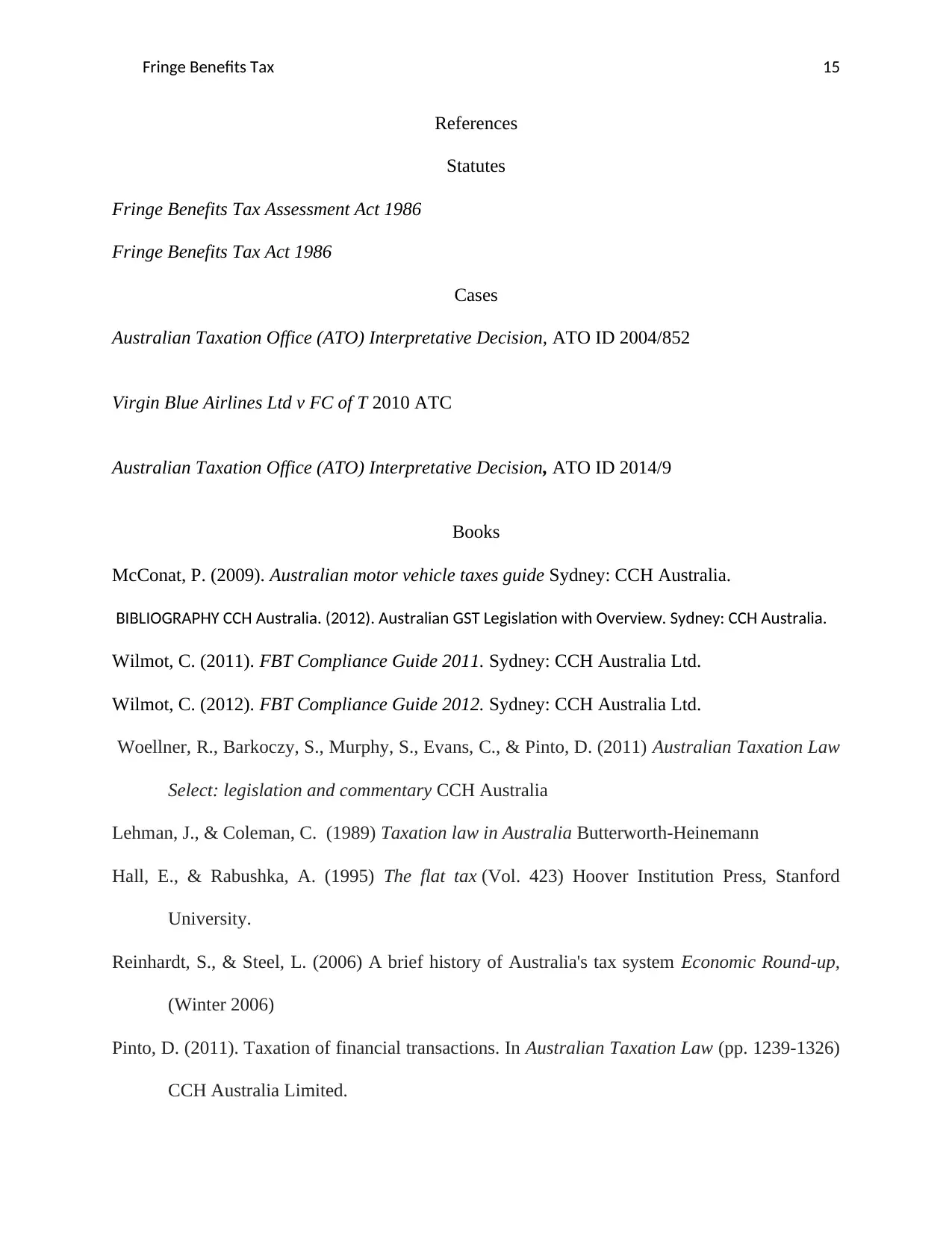
Fringe Benefits Tax 15
References
Statutes
Fringe Benefits Tax Assessment Act 1986
Fringe Benefits Tax Act 1986
Cases
Australian Taxation Office (ATO) Interpretative Decision, ATO ID 2004/852
Virgin Blue Airlines Ltd v FC of T 2010 ATC
Australian Taxation Office (ATO) Interpretative Decision, ATO ID 2014/9
Books
McConat, P. (2009). Australian motor vehicle taxes guide Sydney: CCH Australia.
BIBLIOGRAPHY CCH Australia. (2012). Australian GST Legislation with Overview. Sydney: CCH Australia.
Wilmot, C. (2011). FBT Compliance Guide 2011. Sydney: CCH Australia Ltd.
Wilmot, C. (2012). FBT Compliance Guide 2012. Sydney: CCH Australia Ltd.
Woellner, R., Barkoczy, S., Murphy, S., Evans, C., & Pinto, D. (2011) Australian Taxation Law
Select: legislation and commentary CCH Australia
Lehman, J., & Coleman, C. (1989) Taxation law in Australia Butterworth-Heinemann
Hall, E., & Rabushka, A. (1995) The flat tax (Vol. 423) Hoover Institution Press, Stanford
University.
Reinhardt, S., & Steel, L. (2006) A brief history of Australia's tax system Economic Round-up,
(Winter 2006)
Pinto, D. (2011). Taxation of financial transactions. In Australian Taxation Law (pp. 1239-1326)
CCH Australia Limited.
References
Statutes
Fringe Benefits Tax Assessment Act 1986
Fringe Benefits Tax Act 1986
Cases
Australian Taxation Office (ATO) Interpretative Decision, ATO ID 2004/852
Virgin Blue Airlines Ltd v FC of T 2010 ATC
Australian Taxation Office (ATO) Interpretative Decision, ATO ID 2014/9
Books
McConat, P. (2009). Australian motor vehicle taxes guide Sydney: CCH Australia.
BIBLIOGRAPHY CCH Australia. (2012). Australian GST Legislation with Overview. Sydney: CCH Australia.
Wilmot, C. (2011). FBT Compliance Guide 2011. Sydney: CCH Australia Ltd.
Wilmot, C. (2012). FBT Compliance Guide 2012. Sydney: CCH Australia Ltd.
Woellner, R., Barkoczy, S., Murphy, S., Evans, C., & Pinto, D. (2011) Australian Taxation Law
Select: legislation and commentary CCH Australia
Lehman, J., & Coleman, C. (1989) Taxation law in Australia Butterworth-Heinemann
Hall, E., & Rabushka, A. (1995) The flat tax (Vol. 423) Hoover Institution Press, Stanford
University.
Reinhardt, S., & Steel, L. (2006) A brief history of Australia's tax system Economic Round-up,
(Winter 2006)
Pinto, D. (2011). Taxation of financial transactions. In Australian Taxation Law (pp. 1239-1326)
CCH Australia Limited.
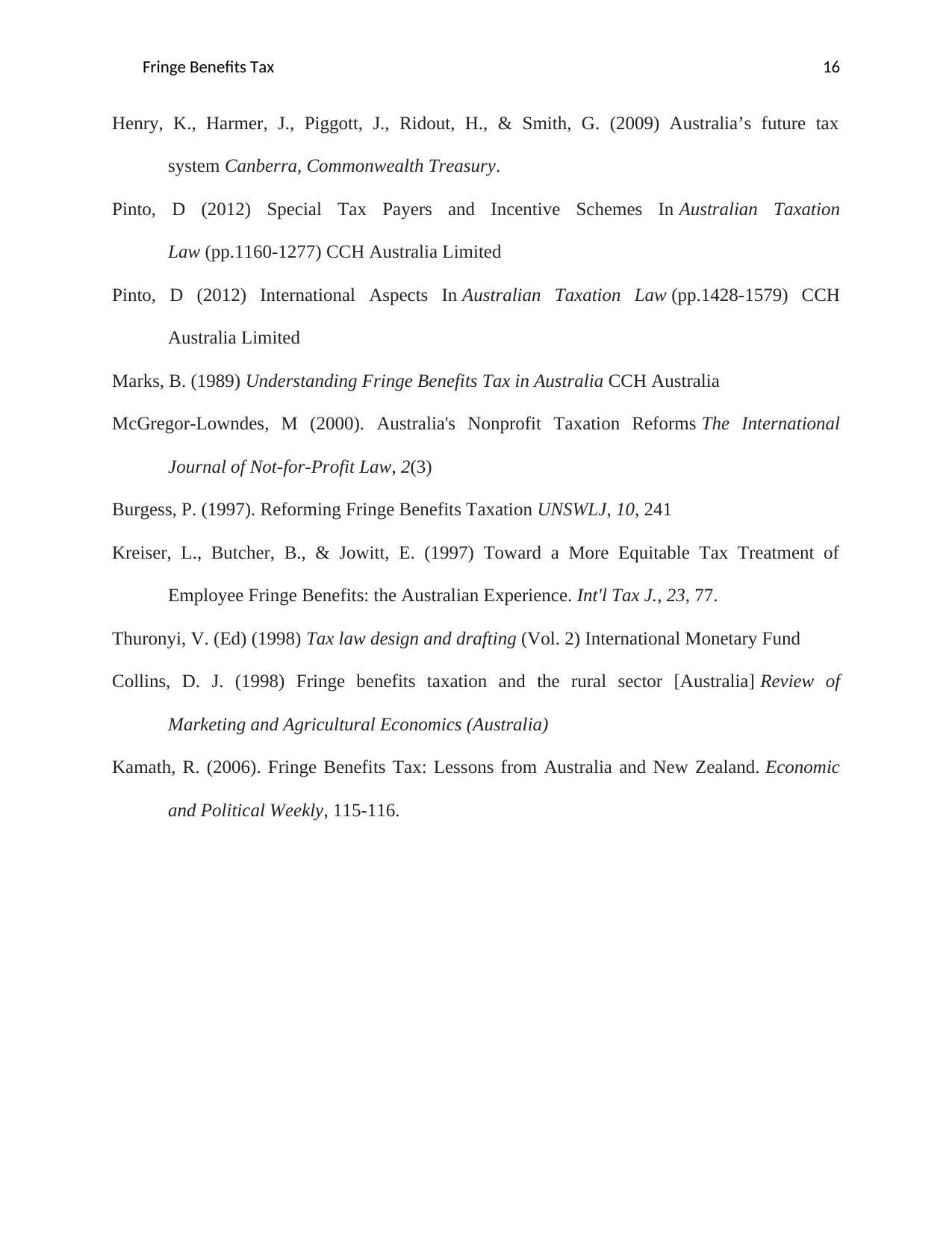
Fringe Benefits Tax 16
Henry, K., Harmer, J., Piggott, J., Ridout, H., & Smith, G. (2009) Australia’s future tax
system Canberra, Commonwealth Treasury.
Pinto, D (2012) Special Tax Payers and Incentive Schemes In Australian Taxation
Law (pp.1160-1277) CCH Australia Limited
Pinto, D (2012) International Aspects In Australian Taxation Law (pp.1428-1579) CCH
Australia Limited
Marks, B. (1989) Understanding Fringe Benefits Tax in Australia CCH Australia
McGregor-Lowndes, M (2000). Australia's Nonprofit Taxation Reforms The International
Journal of Not-for-Profit Law, 2(3)
Burgess, P. (1997). Reforming Fringe Benefits Taxation UNSWLJ, 10, 241
Kreiser, L., Butcher, B., & Jowitt, E. (1997) Toward a More Equitable Tax Treatment of
Employee Fringe Benefits: the Australian Experience. Int'l Tax J., 23, 77.
Thuronyi, V. (Ed) (1998) Tax law design and drafting (Vol. 2) International Monetary Fund
Collins, D. J. (1998) Fringe benefits taxation and the rural sector [Australia] Review of
Marketing and Agricultural Economics (Australia)
Kamath, R. (2006). Fringe Benefits Tax: Lessons from Australia and New Zealand. Economic
and Political Weekly, 115-116.
Henry, K., Harmer, J., Piggott, J., Ridout, H., & Smith, G. (2009) Australia’s future tax
system Canberra, Commonwealth Treasury.
Pinto, D (2012) Special Tax Payers and Incentive Schemes In Australian Taxation
Law (pp.1160-1277) CCH Australia Limited
Pinto, D (2012) International Aspects In Australian Taxation Law (pp.1428-1579) CCH
Australia Limited
Marks, B. (1989) Understanding Fringe Benefits Tax in Australia CCH Australia
McGregor-Lowndes, M (2000). Australia's Nonprofit Taxation Reforms The International
Journal of Not-for-Profit Law, 2(3)
Burgess, P. (1997). Reforming Fringe Benefits Taxation UNSWLJ, 10, 241
Kreiser, L., Butcher, B., & Jowitt, E. (1997) Toward a More Equitable Tax Treatment of
Employee Fringe Benefits: the Australian Experience. Int'l Tax J., 23, 77.
Thuronyi, V. (Ed) (1998) Tax law design and drafting (Vol. 2) International Monetary Fund
Collins, D. J. (1998) Fringe benefits taxation and the rural sector [Australia] Review of
Marketing and Agricultural Economics (Australia)
Kamath, R. (2006). Fringe Benefits Tax: Lessons from Australia and New Zealand. Economic
and Political Weekly, 115-116.
1 out of 16
Related Documents
Your All-in-One AI-Powered Toolkit for Academic Success.
+13062052269
info@desklib.com
Available 24*7 on WhatsApp / Email
![[object Object]](/_next/static/media/star-bottom.7253800d.svg)
Unlock your academic potential
© 2024 | Zucol Services PVT LTD | All rights reserved.





